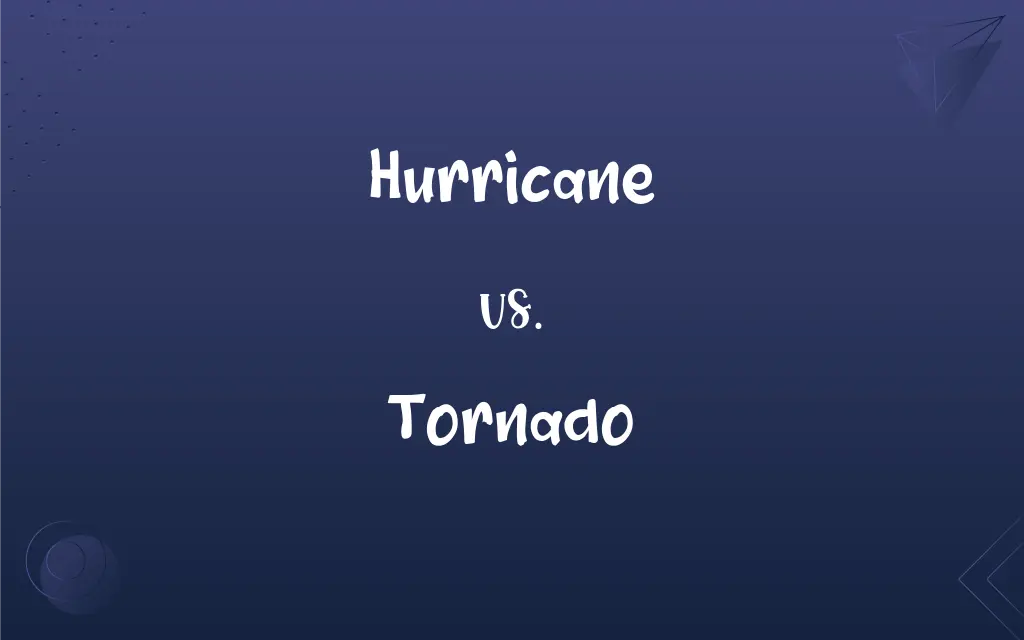Hurricane vs. Tornado: What's the Difference?
Edited by Janet White || By Harlon Moss || Updated on October 13, 2023
Hurricane and tornado differ in size, duration, and formation, with the former being a large, long-lasting storm system over warm ocean waters and the latter being a smaller, short-lived, violent vortex over land.

Key Differences
Hurricane constitutes a significant weather event, notably deriving its energy from warm ocean waters. Tornado, however, typically forms over land, and is, in essence, a rapidly spinning column of air reaching from a storm cloud to the earth’s surface. These two distinctions underscore a vital difference in their respective forming environments.
A hurricane is often characterized by its large-scale, encompassing hundreds of miles, providing it with a notably expansive influence over weather systems. Contrarily, a tornado is significantly smaller in scale, often occupying a space less than one mile wide, but it is substantially more violent and destructive over a localized area due to its intensely concentrated energy.
Hurricane development undergoes several stages, starting from a tropical disturbance and potentially escalating through tropical storm status before becoming a full-fledged hurricane. Tornado, however, can form quite suddenly, often under the right conditions during thunderstorms, rendering them somewhat less predictable and typically providing less warning time.
Hurricane movements are relatively predictable, often enabling accurate forecasting several days before landfall. In contrast, the tornado path can be highly erratic and unpredictable, frequently making its trajectory and subsequent potential impact locations challenging to determine with precision.
Hurricane impacts are often wide-ranging, causing storm surges, widespread flooding, and extensive wind damage over a large area. Conversely, while a tornado can cause catastrophic damage, its impact is usually confined to a much smaller geographical area, albeit with significantly intensified destructive force.
ADVERTISEMENT
Comparison Chart
Primary Energy Source
Derives energy from warm ocean waters
Generally forms during thunderstorms
Scale
Large, spanning hundreds of miles
Smaller, often less than one mile wide
Development Duration
Develops over days, even weeks
Can form suddenly within minutes
Path Predictability
Relatively predictable, trackable paths
Often erratic and unpredictable
Impact
Broad, causing surges, flooding, and wind damage
Localized, but intensely destructive
ADVERTISEMENT
Hurricane and Tornado Definitions
Hurricane
A hurricane typically brings extensive rainfall, powerful winds, and can induce storm surges.
Residents were advised to move to higher ground as the hurricane was expected to cause severe storm surges.
Tornado
A tornado is a violently rotating column of air extending from a thunderstorm to the ground.
The tornado carved a path of destruction through the small town, leveling houses and uprooting trees.
Hurricane
A hurricane is a massive storm system originating over warm oceanic waters.
The hurricane, gaining strength over the Atlantic, prompted evacuations along the coast.
Tornado
Tornadoes often form from supercell thunderstorms, which possess a particular rotating characteristic (mesocyclone).
The ominous supercell thunderstorm looming in the distance had meteorologists on alert for possible tornado formation.
Hurricane
Characterized by a defined eye, hurricanes encompass a spiral arrangement of thunderstorms.
The satellite showed the hurricane’s well-formed eye, indicating its strengthening.
Tornado
Tornadoes can appear transparent until they pick up debris, and their size does not necessarily indicate strength.
The tornado, while not appearing massive, still caused significant damage to structures in its path.
Hurricane
Hurricanes may form in various global locations, often labeled differently, like typhoons or cyclones.
In the Pacific, the hurricane would be referred to as a typhoon.
Tornado
Tornadoes are classified on the Enhanced Fujita (EF) scale, ranking them based on observable damage.
The weather service categorized the tornado as an EF3, indicating it had considerable strength.
Hurricane
Hurricanes are categorized from 1 to 5, with 5 being the most severe, based on their wind speeds.
The hurricane quickly escalated to a category 4, alarming meteorologists and emergency services alike.
Tornado
Tornadoes can occur almost anywhere but are most common in the United States, particularly in "Tornado Alley".
Living in Tornado Alley, residents frequently practice safety drills to prepare for potential tornadoes.
Hurricane
A severe tropical cyclone having winds greater than 64 knots (74 miles per hour; 119 kilometers per hour), originating in the equatorial regions of the Atlantic Ocean or Caribbean Sea or eastern regions of the Pacific Ocean, traveling north, northwest, or northeast from its point of origin, and usually involving heavy rains.
Tornado
A violently rotating column of air extending from a cumulonimbus cloud to the ground, ranging in width from a few meters to more than a kilometer, with destructive winds up to 510 kilometers (316 miles) per hour or higher. Tornadoes are typically associated with a funnel cloud pendant from a storm's wall cloud, often extending to the bottom of the tornado.
Hurricane
A wind with a speed greater than 64 knots (74 miles per hour; 119 kilometers per hour per hour), according to the Beaufort scale.
Tornado
A violent thunderstorm in western Africa or nearby Atlantic waters.
Tornado
A whirlwind or hurricane.
FAQs
What scale is used to categorize tornadoes?
Tornadoes are classified using the Enhanced Fujita (EF) scale, which assesses their intensity based on damage caused.
How is a tornado defined?
A tornado is a rapidly rotating column of air extending from a thunderstorm to the ground, often visible as a funnel cloud.
Can hurricanes spawn tornadoes?
Yes, hurricanes can spawn tornadoes, particularly in their right-front quadrant.
Which areas experience tornadoes most frequently?
Tornadoes are most common in the United States, particularly in a region known as "Tornado Alley."
How long can a tornado last?
Tornadoes can last from several seconds to more than an hour, though most last less than 10 minutes.
Are hurricanes and typhoons the same?
Hurricanes and typhoons are the same weather phenomena, but the naming convention differs based on their location.
Can hurricanes occur in the Arctic?
Hurricanes typically do not occur in the Arctic due to the cold sea surface temperatures.
What is a hurricane?
A hurricane is a large storm system that forms over warm ocean waters and features a well-defined eye.
What impacts can a hurricane have?
Hurricanes can cause storm surges, flooding, strong winds, and spawn tornadoes, affecting large geographical areas.
Can hurricanes occur at any time of the year?
While possible, hurricanes are most likely to occur during the official hurricane season, which varies by region.
Can a hurricane form over land?
No, hurricanes cannot form over land; they require the energy from warm ocean waters.
Where do hurricanes commonly form?
Hurricanes commonly form over warm ocean waters, such as the Atlantic Ocean and the Eastern Pacific Ocean.
How can tornadoes be identified?
Tornadoes are often identified by their funnel shape, rapid rotation, and path of destruction.
How are hurricanes categorized?
Hurricanes are categorized on the Saffir-Simpson scale based on their wind speeds, ranging from Category 1 to Category 5.
What kind of damage can tornadoes cause?
Tornadoes can cause intense localized damage, including destroying buildings, uprooting trees, and hurling debris.
What causes a tornado to form?
Tornadoes often form from severe thunderstorms, especially supercells, when wind patterns and instability are suitable.
Are tornado warnings and watches the same?
No, a tornado watch indicates conducive conditions for tornadoes, while a tornado warning signals a tornado has been spotted.
How large can a hurricane become?
Hurricanes can become extremely large, with some spanning over 1,000 miles in diameter.
How fast can tornadoes travel?
Tornadoes can travel at speeds of up to 70 mph, although speeds can vary significantly.
What time of year are tornadoes most common?
Tornadoes are most common in spring and early summer but can occur at any time of year under the right conditions.
About Author
Written by
Harlon MossHarlon is a seasoned quality moderator and accomplished content writer for Difference Wiki. An alumnus of the prestigious University of California, he earned his degree in Computer Science. Leveraging his academic background, Harlon brings a meticulous and informed perspective to his work, ensuring content accuracy and excellence.
Edited by
Janet WhiteJanet White has been an esteemed writer and blogger for Difference Wiki. Holding a Master's degree in Science and Medical Journalism from the prestigious Boston University, she has consistently demonstrated her expertise and passion for her field. When she's not immersed in her work, Janet relishes her time exercising, delving into a good book, and cherishing moments with friends and family.































































